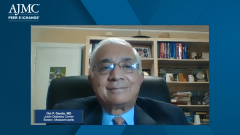
Multisystem Impact of SGLT2 Inhibitors in Cardiorenal Metabolic Syndrome
Jeffrey Turner, MD, discusses the discovery of cardiovascular and renal benefits in SGLT2 inhibitors, and Nihar R. Desai, MD, MPH, provides insight into the role of SGLT2 inhibitors in the four pillars of heart failure.
Episodes in this series

Neil Minkoff, MD: One thing that still strikes me is that as we’re talking about these new treatment paradigms, the SGLT inhibitors went from—on some level, at least on the payer or internal medicine side—not being the predominant treatment for diabetes to now being so for CHF [congestive heart failure] and then cardiovascular disease, cardiorenal disease. Jeff, maybe you could talk about how that’s developed, as well as how SGLT2s have become more widespread with the understanding that there are benefits not just to diabetes but also to the cardiac and renal systems.
Jeffrey Turner, MD: It’s important to appreciate that SGLT2 inhibitors are paralleling what we saw 20 to 30 years ago, with what happened with ACE [angiotensin-converting enzyme] inhibitors and ARBs [angiotensin receptor blockers]. They are now indicated in a vast number of patients with chronic conditions. Data are emerging outside of diabetes, that there’s benefit for these patients. How did this develop? It goes back to a drug called rosiglitazone, which was a popular diabetic drug in the early 2000s and was approved by the FDA—a blockbuster, a multibillion dollar drug that improved glycemic outcomes. After being on the market for some years, it was found to have increased cardiovascular outcomes. That really shifted the FDA’s approach to approving these medications and evaluating diabetes medications. Then came the SGLT2 inhibitors, which were initially conceptualized as innovative drugs to treat diabetes. We put them on the market and had the additional barrier of proving that they improve cardiovascular outcomes along with glycemic controls, and the signals shown in those original trials meant for diabetes proved that they have some benefits in cardiovascular outcomes. What has emerged now that we all appreciate is that while these drugs were initially conceptualized as diabetes drugs, it turns out they’re really heart failure drugs, as well as chronic kidney disease drugs, that happened to have a bit of a diabetes effect. A few years from now, they’re going to be widely utilized. Many of us are already prescribing them in large numbers, and that will only go up in coming years.
Neil Minkoff, MD: Do we know why there’s such a widespread effect of these drugs on multiple systems?
Jeffrey Turner, MD: That’s been a topic of interest, both in nephrology and cardiology, so it’s been debated. How do these drugs lead to improvement in organ function, or at least protection of those organs from getting worse? Different theories have emerged. The most common theory is that these drugs have a natriuretic effect, so they help excrete salt out of the body from the kidneys, which is a mainstay of therapy for heart failure and is also important for blood pressure and kidney disease protection. That’s only part of the story, or maybe even a small part, and these drugs are being recognized as rewiring some of the cell metabolism that goes on. Some folks have hypothesized that it puts these cells in these various tissues and promotes what’s been described as a hibernating state, which leads to protective effects in these organs and tissues in the long run and from the day-to-day wear and tear that happens in the setting of diabetes, obesity, high blood pressure, etc. Our understanding of how these protective effects occur is still evolving, but we know they alternate the hemodynamics within the glomerulus and the kidney. They have direct protective effects on the myocardium. There’s still a lot more to be understood about how they have all these benefits.
Neil Minkoff, MD: One of the things that I keep stumbling upon as I try to understand how these things interrelate, and as I try to understand heart failure in general, is the phrase “4 pillars of heart failure.” Could you explain them?
Nihar R. Desai, MD, MPH: In the initial clinical trials that were done of the SGLT2 inhibitors, they were all patients with diabetes. One of the things that we saw was that there seemed to be cardioprotective effects of these medications. There were also dramatic reductions in heart failure hospitalizations. Many of the drugs were then going to be tested in dedicated trials of patients with heart failure, regardless of whether the patients had diabetes or not. That’s a real paradigm shift. What started as a set of therapies and clinical trials in patients with diabetes rapidly shifted to an evaluation of these therapies among patients with reduced ejection fraction or systolic heart failure, regardless of whether the patients have diabetes or not. What was observed was very dramatic, almost a 30% to 35% reduction, in heart failure hospitalizations. If you put all of these together—dapagliflozin and the DAPA-HF trial and then empagliflozin and the EMPEROR-Reduced trial—it seems like there may also be a reduction in cardiovascular death, as well as reduction in adverse renal events. Among patients with heart failure, regardless of whether the patients have diabetes, you can see dramatic reductions in heart failure hospitalizations and other clinical events that are of relevance to our patients. Given the data that we’ve initially seen for dapagliflozin, and now for empagliflozin, there has to be a paradigm shift in the way that we think about guideline-directed medical therapy for heart failure. What we used to talk about was triple therapy, or the 3 pillars: beta-blockers, ACE inhibitors, ARBs and ARNIs [angiotensin receptor neprilysin inhibitors], and then mineralocorticoid receptor antagonists. We’ve seen such a dramatic benefit with the SGLT2 inhibitors that we’ve shifted and now are talking about quadruple therapy as being the standard of care for heart failure. That is where the 4 pillars came from. You’ve got the beta-blockers, the ACE inhibitors, ARBs and ARNIs, the mineralocorticoid receptor antagonists, and now the SGLT2 inhibitors as the 4 pillars for heart failure therapy.
Transcript edited for clarity.
Newsletter
Stay ahead of policy, cost, and value—subscribe to AJMC for expert insights at the intersection of clinical care and health economics.






























































